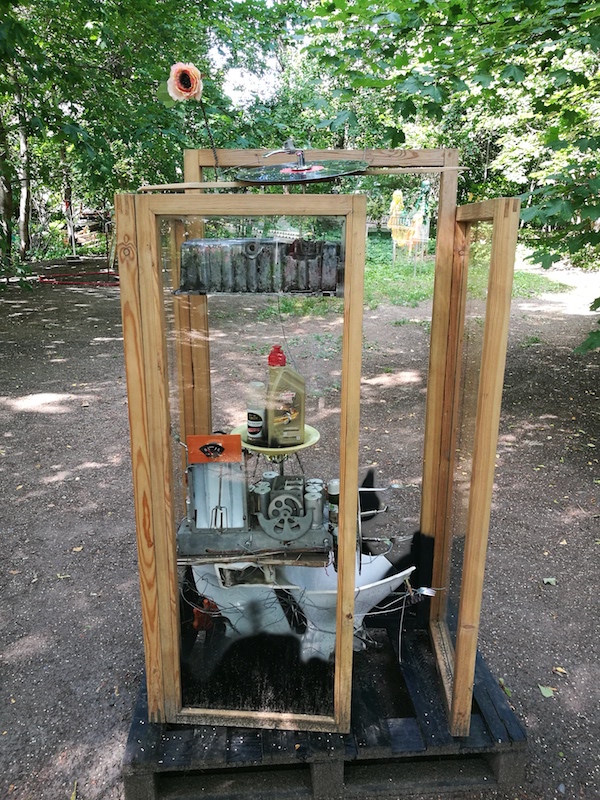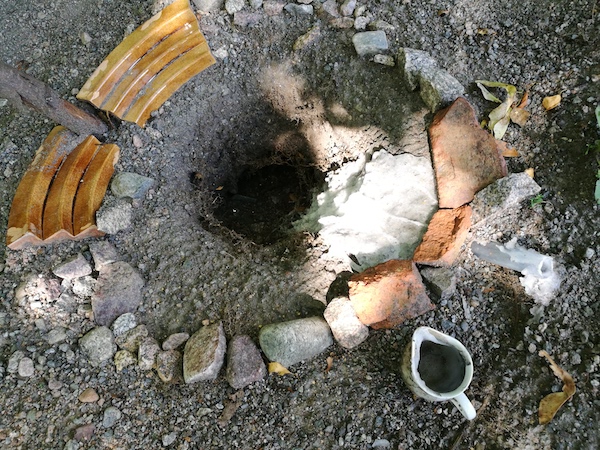Pipoca (Paola de Ramos) invited me to participate in an art exhibition and residency at Hirvitalo, Pispala, Tampere, Finland in July 2019, the theme – Tavaissa – ‘in the sky’. As part of this summer experience. I stayed in the gallery for two weeks with fellow artist Riitta Hakkarrainen to work on a site-specific contribution. During this time, we were part of the workings of this unique institution, the Elk House, Hirvitalo.
Run by artists for artists, Hirvitalo is based in an old house on the Elk Road down to the lake
An active place for experimental arts to perform and exhibit among the fruit trees and the vegetable patch, with a gallery that goes over two floors It, began as a collective operation thirteen years ago and its philosophy and group remain roughly intact.

Before moving into this old house, the artists were working upstairs at the Kurpitsatalo (Pumpkin House) and were lacking the space to express themselves. The makers and activitists were cramped. Their art required a different environment. Also, when exhibiting in more traditional spaces, their art was being over-censored by conservative attitudes and as a group, the younger, radical artists were suffering from an overarching interest in the arts as decorative, domestic and historical. They were frustrated, like birds with their wings clipped.

Taking matters into their own hands, the young artists, a medium-sized core group of about 20 to 30, initially squatted a disused space and began to use their skills to renovate the old building. Alongside bringing the structure back to useability, the artists were free here to express their wide range of art and eco-interests, turning this promising but neglected space into a heart of DIY culture. Beautifully located in this idyllic resort-area on the side of the lake, these artists are now connecting with an international art scene, showcasing the talent of the current generation and contributing to the overarching popular movements of ecology and protest.
Chair Sami Maalas guided me round the recent history of the organisation. His own work includes a series of raft-making interventions and performances. These structures enable magical experiences, allowing participants to connect with the pagan and physical past. By building simple raft spaces with woodlike installations, including living plants, he makes it possible for participants to sail off into a distant space, allowing human spirits to open up to their water-going personalities. This work is now on hold, but he is developing and improvising other avant-pieces.
Performanssifiesta brings intriguing happenings to the local community. Performances that are half-character, half-experimental music, half-visual, half-impossible tug, roll, pull, slide observers through the streets and forests, dragging those it encounters into an alternative reality for a moment, an hour, and gives an experience of wonder that may last a lifetime. Community is at the heart of Hirvitalo. Dogs, children, visitors passing on their way to swim in the lake are all welcome to enter the grounds and make their own adventure here, to visit the free gallery that is open from 2pm-7pm. As a guest, you do not have to be immersed in the experimental scene to benefit from their risk-taking art-making. The space is also utilised for other health-related sessions, including therapeutic sessions.
I take a walk with Sami around the sculpture garden. For the summer, the outside space has become a temporary gallery. Pieces by artists created in a workshop led by Steve Vanoni (Sacramento, California but living in Tallinn, Estonia) have been installed among the trees. We stop at a particularly intriguing piece, re-imagining archaeology. I pump earth from the ground and watch it fly about, little showers of mud. A sheet is buried underground, with the instruction to dig it up in 2020. The process, the concept and the time scale of archaeology imaginatively collide in this interactive moment. This interactive piece by Jenni Rutanen makes me reflect on tourism of the picturesque as well as archaeology, how we desire to have a relation with the physical remains of our past and natural phenomenon. There is even a tiny waterfall, a model of an imaginary beauty spot of the Tampere area, animated the participant adding water from a small jug.

The piece by Jonne Kauko is also playful but with a darker mood and purpose. Encased in a glass cabinet, there is a Heath Robinson style machine in which a record goes through various processes, oil for a car engine, wire, mechanical innards to finish in a broken toilet. The workings of the modern mind, with its connections with the contemporary machine, are represented and museumised by the cabinet. Beneath a nearby tree, Taina Valkonen has filled a metal bowl with tubes labelled with commentary on alternative medications. Will new concoctions with new intentions help save the planet? The Finnish labels are translated to me as ‘salve for an anarchist’s wet dream’, ‘let’s fight together lubrication’ and ‘preventing over-population lotion’.
This is the third ‘Com-Post-Modern’ workshop and there are plans for another in 2020. For the workshops, Steve Vanoni and his group visit the local landfill, for which permission has been applied for, and this provides strong, distinctive materials which are later disposed of responsibly. Hirvitalo has recycling as a central philosophy. This is emphasised to me by all members of the artistic community, by the many volunteers who clearly passionately believe in what is being achieved here.
The community group takes an active interest in the history of the building. Built in 1924 by the painter-decorator Gronlund, Hirvitalo (Elk House) seems to be enjoying its new lease of life. Sami calls the approach ‘punk shui’, in which elements of the building are preserved and exposed. A book which presents the history of the collective includes photographs and commentary on the history of the house on its crossroads location. Carpet beaters, cats, men standing around in the deep snow, freezing and keeping themselves comfortable, and the struggles, failures and successes of the local community are included and become a resource for their creative inheritors. One of the smaller garden pieces is the blue tube for a washing machine made by Minna Soraluoma. Wittily and with careful craft, she has twisted the pipe into – the shape of a carpet beater!

Tampere is second largest urban population in Finland after Helsinki and is applying for European Cultural Capital for 2026. In this bid, Hirvitalo should be a huge asset. This cultural space, run by a successfully functioning, self-directed collective with a long-running history that already stretches back over 15 years, cannot be created overnight or imposed from above. My own ideal for city arts is for multiple organisations to work together, fostering diversity and community rather than homogenising output. I worked for many years in community arts in the East End of London and saw how the smaller and medium-sized operations run from the ground-up gave a sense of ownership and freedom which is the fuel of new, alternative, emerging and community arts who generally feel oppressed and excluded by overarching institutions. There are a vivacity and energy to Hirvitalo which harnesses young, radical spirits to the common cause of human creativity at this moment, at this space, in this place. Culture does not bloom by magic and wishful-thinking, or even by showering money. It comes from the people of the earth.
Words/Photos: Jude Cowan Montague © Artlyst 2019
Com-Post-Modern Scultpure for the Avant-Gardeners III
6 -30 July 2019
Mikko Kallio Jonne Kauko, Johanna Lonka, Venla Martikainen, Hannamari Matikainen, Onnelliset ihmiset, Ilkka Piirainen & Heini Hiltunen, Jenni Rutanen, Sanni Seppä, Minna Soraluoma, Valpuri Talvitie, Taina Valkonen. Led/curated by Steve Vanoni with Jenni Hiltunen.
Taivassa / in the sky 13 July – 1 August 2019 – Darya Apakhonchich, Mariana Barros, Ana Maria Lima Dimitrijevic, Rosa Farber, Riitta Hakkarainen, Yoojin Lee, Jude Cowan Montague, Pipoca, Ania PsH, r-tiiika, VishnuVardhani. Curated by Pipoca (Paola de Ramos)

